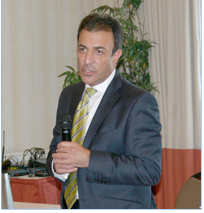GELFAND’S WORLD-Who would imagine that investment bankers and venture capitalists would be leading the next environmental revolution? Maybe not all of them, but there were certainly a lot of the financial types mixed in with visionary engineers and builders at the GloSho, a workshop on what is colloquially referred to as green tech. One conclusion: building a more efficient electric motor or recycling agricultural waste may be more effective ways of saving the planet than paying dues to your friendly environmental organization.
The meeting, held at the LA Theater Center, was sponsored by the LA Cleantech Incubator] (Laci for short) this week of October 6, 2014. It was remarkable for the breadth of subject matter as well as for the collection of companies and, indeed, countries that are working hard to make green technology a reality.
Here is one tidbit from the meeting. A company called NanoH2O has an effective method of desalinizing water using the technology known as membrane filtration. The technology came out of work done in a lab at UCLA. It was developed in small scale in El Segundo, and now is being put into full sized desalting plants all over the world.
A couple of other tidbits. Think about the near future when electric cars will be a much larger fraction of the total. The current practice is for businesses and parking garages to provide one or two charging stations. What happens when there is a need to charge lots of cars?
The engineers and their financial backers have been thinking about this question, and they have answers (and products) ready to fill the need. One company has specialized in developing systems where cars can all be hooked up, but can be recharged a few at a time according to priority. The guy who has to leave at noon can get his car charged right now, while the executive who never leaves before 7 will have a fully charged car available at that point. This contributes to load balancing, meaning that the power company can deliver a steady flow of electricity rather than deal with sharply spiking peak loads.
Another company has developed moveable charging stations which can go from car to car.
The take home lesson of the meeting, at least for me, goes like this. The idea of a clean and green future is not a certainty, but a lot of talent and investment money is going into the products and services that will be required if and when some futuristic technologies come into widespread use. Some services, such as making drinkable water out of ocean water, are obvious targets. Other worthy goals, such as solar-electric panels on every roof, are less certain, but the high tech people will have products and systems ready when the time comes.
In other words, the engineers and scientists have been thinking ahead of their time, and the investment money is sensing a trend and trying to follow it.
It's nice to know that there is a lot of research and development (accent on the development part), that it is going on right here in Los Angeles, and that technology incubators are playing a part.
 An interesting perspective was offered by somebody who is known to many of the neighborhood council participants of the past decade. David Nahai (photo left) was at one time the director of the LA Department of Water and Power, and was our guest at the Los Angeles Neighborhood Council Coalition and at the DWP oversight committee.
An interesting perspective was offered by somebody who is known to many of the neighborhood council participants of the past decade. David Nahai (photo left) was at one time the director of the LA Department of Water and Power, and was our guest at the Los Angeles Neighborhood Council Coalition and at the DWP oversight committee.
He agreed to a brief talk, and made the following point: The environmentalists of the last generation have become the environmental businesses of the current generation.
It's an interesting way to look at things. In defense of that idea, I collected a stack of business cards and brochures from clean tech incubators from around the region and from around the world. One such place in the region of Turin, Italy, is working on a host of projects, including the above-mentioned idea of industrial scale recycling of agricultural waste products into usable chemicals, foods, and materials.
The Hidrocreto group in Mexico has developed a substitute form of pavement that allows rain water to flow right through it and into the ground, and thereby recharge the water table. Perhaps as parking lots and streets wear out and require repaving, we can make a conscious decision to repave with a porous surface that will preserve some of the rainwater as groundwater, saving what would otherwise run into the LA River and then into the ocean. It's a long term dream of local environmental groups, and a cement company may make it happen. They showed a 35 second video of the product in action.
 The underlying assumption for a lot of participants was that solar power is the coming thing. The engineers have been working on developing more efficient solar panels and the systems that connect them together. For example, if you connect a dozen solar panels together, one weak panel drags the whole system down. Likewise, if one of them is a little stronger than the others, then its excess power is lost as waste. One inventor came up with a light, cheap connection box that solves the problem.
The underlying assumption for a lot of participants was that solar power is the coming thing. The engineers have been working on developing more efficient solar panels and the systems that connect them together. For example, if you connect a dozen solar panels together, one weak panel drags the whole system down. Likewise, if one of them is a little stronger than the others, then its excess power is lost as waste. One inventor came up with a light, cheap connection box that solves the problem.
Other engineers are working on developing solar panels of ever-increasing efficiency. One group from southern Italy had particularly promising results which could double the current level of efficiency.
There were not a lot of biotech projects presented, but there were a certain number of biologists and chemists in attendance, and I got a chance to chat a bit at the post-event cocktail party. (It's interesting that my technical articles often involve these post-event cocktail parties. Do biologists just drink more?) One of them, working at a San Diego startup, is involved in growing algae as a source of food and fuel, and seems to have the hard questions solved.
Another, a physical-organic chemist from USC, talked to me about an alternative to the way we build storage batteries nowadays. Instead of doing the old thing, which is currently Lithium ion, he suggests using electricity to turn CO2 into methanol, which is usable as a fuel and as the input to synthesis of other useful chemicals and structural materials. He mentioned that the process is already being tried in Iceland.
{module [862]}
{module [662]}
We had lots of fun arguing the respective merits of chemical reduction (that means adding electrons) by photosynthesis vs. photovoltaically. Sorry. Forget I mentioned it. But in a world without cheap petroleum, such discussions are critical.
It's nice to see that young minds are applying their talents to what this world is going to need, and that the financial sector is at least aware that the green economy is one area that is ripe for participation.
Just for fun, here is one more product we saw, the Juicer Bike. It's an all-electric bicycle with a racy look, built to resemble a motorcycle from 100 years ago.
Going back to David Nahai's comment, I'm not sure if the environmentalists have become the environmental businesses, or that business investment is following an environmentalist direction that is determined by real world facts. However you want to approach the topic, there is an increasing human population, decreasing petroleum supplies, and the realization (sometimes grudging) that worldwide reduction of CO2 emissions is an absolute must. It really doesn't matter which is the tail and which is the dog. What matters is that the technological evolution into more CO2-neutral manufacturing and transportation is the coming thing.
(Bob Gelfand writes on culture and politics for CityWatch. He can be reached at [email protected])
-cw





